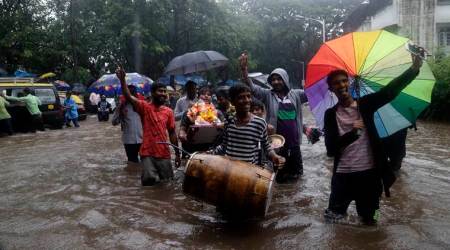 Planes queued up at Chhatrapati Shivaji International Airport, Mumbai, on Tuesday. Thirteen go-arounds and seven diversions of flights were reported by evening due to heavy rain and poor visibility. Ten flights were cancelled. Many passengers were stuck at the airport due to lack of local transportation. (Express Photo/Amit Chakravarty)
Planes queued up at Chhatrapati Shivaji International Airport, Mumbai, on Tuesday. Thirteen go-arounds and seven diversions of flights were reported by evening due to heavy rain and poor visibility. Ten flights were cancelled. Many passengers were stuck at the airport due to lack of local transportation. (Express Photo/Amit Chakravarty)
Amid fears of a repeat of the July 2005 deluge, the Indian Meteorological Department’s weather station in suburban Mumbai recorded 315.8 mm of rain in 12 hours ending 8.30 pm on Tuesday, the highest such 12-hour precipitation ever recorded in Mumbai since the 944 mm rainfall recorded on July 26, 2005.
Even with state agencies and citizens relying on social media in a manner that would have been unthinkable in 2005, the delayed mid-morning advisories to citizens proved futile as the suburban railway, the financial capital’s lifeline, remained paralysed from late afternoon until well past 9 pm, leaving harried citizens stranded in south Mumbai. A two-year-old girl, Kalyani Gopal Jangam, died when the shanty her family lives in collapsed in Parksite.
Even at 9 pm, traffic pile-ups in south Mumbai could not be completely resolved. Thousands of stranded citizens hunkered down in offices, schools, railway stations, and at strangers’ homes, long after the rains slowed, with railway tracks still submerged and various roads still inundated.
Services on Central Railway’s main and harbour lines remained suspended until 9 pm with waterlogging at various points. Officials said pumps installed to remove water proved inadequate. The first train after services were suspended started from Thane after 9 pm. “We are trying to resume services from Chhatrapati Shivaji Maharaj Terminus (CSMT) towards Thane. Services on the trans harbor line have resumed,” an official said. Regular services in the direction of suburbs did not resume from Churchgate station until past 9.30 pm.
As commuters shared harrowing tales of being stuck in trains and in traffic for up to seven or eight hours hours, authorities appeared to have been taken by surprise. The IMD had issued a forecast of heavy to very heavy rains early Tuesday, but people were alerted by noon.
What worked:
– Agencies followed various operating procedures set out for circumstances such as these. Agencies coordinated, NDRF was rushed in, Navy and Coast Guard were on guard and lifeguards at beaches were on high alert.
– Social media, not so all-pervasive in 2005, was used by agencies as well as citizens to offer help, share information and updates. Mumbai Police, particularly, was excellent on Twitter, even offering help to citizens who tweeted information about where they were stranded.
– Unlike 2005, the CCTV network now in place helped the Mumbai police to monitor major spots and try to manage traffic.
What didn’t:
– Mumbai’s famed suburban train services collapsed leading to a gridlock on the city’s arterial roads, resulting in chaos for commuters.
– The pre-monsoon cleaning of drains, long seen as a scam-ridden and contractor-controlled, was simply not up to the mark.
– Calm, sensible and well thought out advisories to citizens were missing. There were no messages in the morning hours though the IMD had predicted very heavy rains. By afternoon, agencies and politicians began tweeting, asking people not to venture out.
– Railway PA systems did not offer information on how many trains were bunched up ahead of a station.

